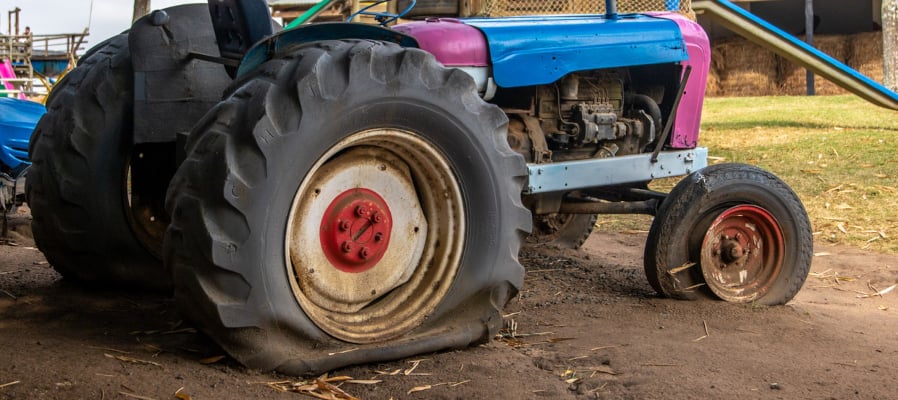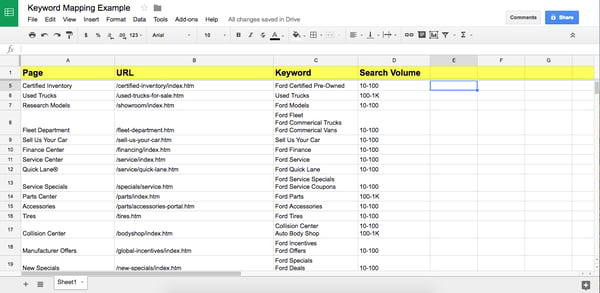It might sound decidedly unpleasant, but keyword cannibalisation is actually a relatively mundane (and surprisingly common) problem that affects thousands of B2B and B2C websites.

In layman’s terms, it’s when two or more of your web pages try to target the same keyword; diluting your chances of ranking a specific piece of content and undermining your SEO strategy.
Think of it like this: Jeff is the CMO of a tractor company. He’s driving home from work one day when he decides to tune into a fantastically informative podcast that extolls the benefits of creating high-value content for your website.
Inspired, he gets home and sets to work writing 3 articles: ‘How To Choose A Small Tractor’, ‘Why You Need A Small Tractor’ and ‘The Advantages Of Owning A Small Tractor’.
He means well, but his articles will all cannibalise each other because they’re chasing the same search term: ‘small tractor.’
When Googlebot or another web crawler visits his site, it’ll see three articles that could be ranked for “small tractor” but asking Googlebot or any other automated indexing software to choose between three different pages is risky business: For starters, Google and other search engines tend to show one or two results from the same domain in the search results for a particular query, so at least one of Jeff’s articles is never going to see the light of day.
Secondly, Google now gets to pick which of Jeff’s articles it should rank for ‘small tractor’ and it might not be the article best-suited to generating new leads and winning Jeff some new customers.
Let’s say his article titled ‘How To Choose A Small Tractor’ contained links to some of his most popular product pages, but his article on ‘The Advantages of Owning A Small Tractor’ was a rush-job that he published without putting any contact info or product links on the page. It’s an extreme example. If Google chooses to rank the latter article and not the former, Jeff is missing out on a lot of potential customers.
Then there’s the prickly issue of ‘link juice’ dilution to contend with: As Search Engine Journal is quick to point out, Inbound links from tractor bloggers, farming enthusiasts and horticulture experts will now be spread between three pieces of content instead of pointing towards one - super authoritative - article that would have looked much more attractive to those ever-hungry search engine crawl bots.
But it’s the missed opportunities that make keyword cannibalisation really hard to stomach (pun fully intended). See, each one of Jeff’s carefully-written and incredibly-thoughtful articles could be ranking in the number one slot for a slightly different keyword.
He could have ranked ‘How To Choose A Small Tractor’ for ‘Tiny Tractor’ if he’d changed one word, or put a piece of content in front of a much more specific and engaged audience by adding the name of a popular tractor brand to his article titled ‘Why You Need A Small Tractor’
Instead, he’s written three pieces of content that are striving to rank for one, highly competitive keyword at the expense of all the fantastic traffic he could have scored by spreading the net a little bit wider.
Silly Jeff.

Wait, Have I Got Keyword Cannibalisation Problems?
Scary thought isn’t it? Luckily, there are two easy ways to check whether you’ve done a Jeff. First, you can use Google search operators to sniff out any potential problems. Just pick a keyword (preferably an important one), head over to Google and search for ‘inurl:yourwebsitehere.com “target keyword”’ and hit enter.
In about half a second, Google will serve you up a list of the pages on your site that currently mention your keyword.
Now, it's worth noting that this isn’t an exhaustive list of pages that are currently cannibalising each other: A simple mention of a keyword isn’t enough to confuse Google or cause a cannibalisation issue and it’s actually fairly normal to mention one word or phrase on multiple pages of your site.
What we’re trying to watch for is pages that are optimised for the same keyword, as in pages that:
- Mention the keyword several times
- Have the target keyword in their title element
- Have the target keyword in their meta description
- Mention the target keyword in one or more <h1> or <h2> tags
Because it’s this level of optimisation that will - ultimately - force Google to start evaluating multiple articles for the same keyword.
In the example pictured above, we’re probably a bit guilty of over-optimising our blog post home page for SEO related keywords but there’s no other major concerns of note. However, if we perform the same exercise for ahrefs.com, we can see that they’re trying to rank a lot of content for the same keyword – with mixed results.
Stark contrast to the way Interflora have approached keyword ranking, which is very clean and neatly avoids a lot of potential cannibalisation issues:
The second (and more accurate) way to check for keyword cannibalisation on your site is to head over to Google Search Console; a free tool designed to help you stay on top of your SEO and optimise the visibility of your website.
Once you’re logged into Search Console, you’ll want to click performance, and then select “New Query” using the button at the top of the page.
Now type your chosen keyword into the prompt and click enter, then select “pages” from the tray below the central graph:
This screen shows you all the pages currently ranking for your chosen keyword and their respective rankings. If there are lots of pages on this list, you’ll know that Google is currently trying to rank multiple pages for the one search term. Meaning that you have a current and ongoing issue with keyword cannibalisation.
But don’t panic just yet – there is a remedy.

How Do I Fix Issues With Keyword Cannibalisation?
The million dollar question. Some experts recommend that you remove content that competes with the page you want to rank for a specific search term – implementing some 301 redirects to link all the cannibalising content to a single - more authoritative - page. (Source: SearchEngineJournal)
The experts over at SEMRush also recommend implementing canonical tags to tell Google that your money page (that’s the page you want to rank) is the definitive or ‘master’ version of the content that you want to see ranking for your target keyword – and that all the other pages are simply rehashed versions of the same. (Source:SEMRush)
But we think that both of these approaches waste valuable collateral. You're basically telling Google to ignore several pages of perfectly good content and as we pointed out earlier in this article, Jeff could have easily made a few small tweaks to his articles to get them ranking for different - but equally important - search terms; diversifying to make his content work harder for his brand.
That’s why we normally tackle cannibalisation issues with a keyword mapping exercise. Simply put, we look at every page on a website and try to work out:
- Which keyword(s) it currently targets
- Which keyword(s) it could target instead
- What we’d have to do to successfully retarget the page
More often than not, this is just a case of tweaking the keywords used in the page title element, meta description, <h> tags and body content.
But getting to grips with your website’s content can be an uphill battle. Particularly if your site’s old and you’ve got hundreds of pages to comb through. To get things started, fire up your favourite spreadsheet programme and try to find your website’s XML sitemap.
This is a list of all the pages currently on your website and it’s normally found by googling www.yourwebsitenamehere.com/sitemap.xml. You may also find a link to your sitemap in your website’s footer, or by heading to Google Search Console and clicking on “Sitemaps”
Why Do I Need My XML Sitemap?
We’re using your XML sitemap because it’s generally the most accurate and definitive list of the content currently on your website, but if you can’t find it (or you don’t have one) you can always try to export a list of current pages from your CMS and/or ask your dev team for a list of current urls.
The important thing is to try and find a fairly accurate list of content so that you don’t miss pages or leave any cannibalising content floating about in the ether.
Once you’ve got a list of your current site content, dump it into a spreadsheet and start assigning a target keyword for each page, leaving you with something that looks a bit like this:

Finding target keywords can be a bit tricky, but there are several good guides to SEO keyword research out there on the net, including some excellent resources from SEMRush and Ahrefs.
Mapped out your keywords? Fantastic. Now you just need to find the time to pick through your content and implement the necessary tweaks.
And yes, we know that’s probably a lot more work than you’ve got time for. Thing is, retargeting competing pages is by far the most effective way to tackle cannibalisation issues and you’ll be well-rewarded for the time spent re-optimising your content.
If you’re really up against it and you need professional help with a keyword mapping exercise, our marketing team may be able to help. Just give us a call or use the form on our contact page to tell us what you’re struggling with and a member of the team will be in touch.

